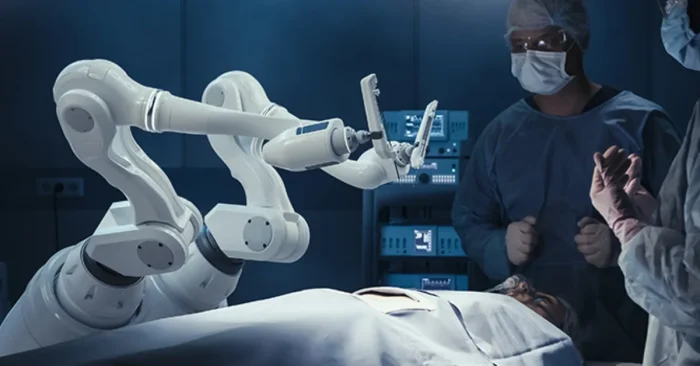Overview
AI tools for robotic surgery are revolutionizing modern surgical procedures by combining artificial intelligence with robotic precision. These tools assist surgeons in performing complex and minimally invasive surgeries with higher accuracy, reduced complications, and shorter recovery times.
AI algorithms analyze preoperative imaging, provide real-time guidance during surgery, and optimize instrument movements. Robotic systems enhanced with AI improve hand-eye coordination, motion scaling, and tissue recognition, ensuring precise interventions. Widely adopted in hospitals and surgical centers, AI-powered robotic surgery tools enhance clinical outcomes, support personalized surgical planning, and increase efficiency in the operating room. By integrating AI, robotic surgery becomes safer, more effective, and highly adaptable across various surgical specialties.
1. da Vinci Surgical System – Intuitive Surgical
The da Vinci Surgical System combines AI and robotic technology for minimally invasive surgeries. AI assists in instrument control, motion scaling, and real-time visualization, enhancing precision and reducing surgical risks. Surgeons benefit from improved dexterity and accuracy, especially in complex procedures like urology, gynecology, and cardiothoracic surgeries.
2. Versius Robotic System – CMR Surgical
Versius integrates AI with robotic arms for flexible and precise surgical operations. AI algorithms guide instrument movement, optimize surgical workflow, and provide real-time feedback. The system supports minimally invasive procedures, reduces recovery time, and improves overall surgical efficiency and patient outcomes.
3. Senhance Surgical System – TransEnterix
Senhance combines AI with robotic-assisted laparoscopic surgery. AI enhances haptic feedback, instrument tracking, and motion precision. Surgeons receive real-time guidance, which reduces fatigue, improves accuracy, and supports minimally invasive techniques across multiple surgical specialties.
4. Monarch Platform – Auris Health
Monarch Platform integrates AI with robotic-assisted endoscopic procedures. AI algorithms provide navigation guidance, analyze imaging data, and optimize instrument positioning. The platform supports pulmonology and other minimally invasive surgeries, improving procedural accuracy and patient recovery.
5. Ottava Surgical Platform – Johnson & Johnson
Ottava combines AI with robotic systems to assist in complex surgical procedures. AI guides instrument control, motion scaling, and intraoperative decision-making. Surgeons benefit from enhanced visualization, precise navigation, and improved workflow efficiency, resulting in better patient outcomes.
6. ROSA – Zimmer Biomet
ROSA uses AI-driven robotics for neurosurgery and orthopedic procedures. AI algorithms assist in planning, instrument navigation, and real-time monitoring. The platform improves surgical precision, reduces risks, and supports minimally invasive approaches, enhancing both clinical outcomes and patient safety.
7. ExcelsiusGPS – Globus Medical
ExcelsiusGPS integrates AI with robotic guidance for spine and orthopedic surgeries. AI assists in accurate implant placement, trajectory planning, and motion optimization. Surgeons benefit from enhanced accuracy, reduced operative time, and improved patient recovery, making robotic-assisted surgery safer and more reliable.
8. Mako Robotic-Arm – Stryker
Mako combines AI with robotic-arm technology for orthopedic joint replacement procedures. AI algorithms assist in preoperative planning, real-time guidance, and precise implant placement. The system improves surgical accuracy, reduces complications, and enhances post-surgical outcomes for patients undergoing hip and knee replacements.
Navio integrates AI and robotics for orthopedic surgeries. AI assists in bone mapping, instrument guidance, and real-time adjustments during procedures. The platform ensures precise implant positioning, reduces human error, and improves surgical efficiency and patient recovery.
10. Acuson NX3 – Siemens AI Robotic Assistance
Acuson NX3 combines AI with robotic-assisted imaging and surgical guidance. AI algorithms analyze patient anatomy, guide robotic instruments, and enhance intraoperative visualization. The platform supports complex surgeries with precision, reduces operative risk, and enhances surgical outcomes through AI-driven assistance.
(FAQs)
Q1: How do AI tools enhance robotic surgery?
AI tools provide real-time guidance, instrument control, motion scaling, and imaging analysis, improving precision, reducing errors, and optimizing surgical outcomes.
Q2: Are AI robotic systems suitable for minimally invasive surgeries?
Yes, platforms like da Vinci, Versius, and Senhance are specifically designed for minimally invasive procedures, enabling high precision and faster recovery.
Q3: Can AI robotic surgery improve patient recovery?
Absolutely, AI-assisted robotic surgery reduces complications, minimizes tissue damage, and supports precise interventions, leading to faster and safer patient recovery.
Learn More About AI Course https://buhave.com/courses/learn/ai/
















